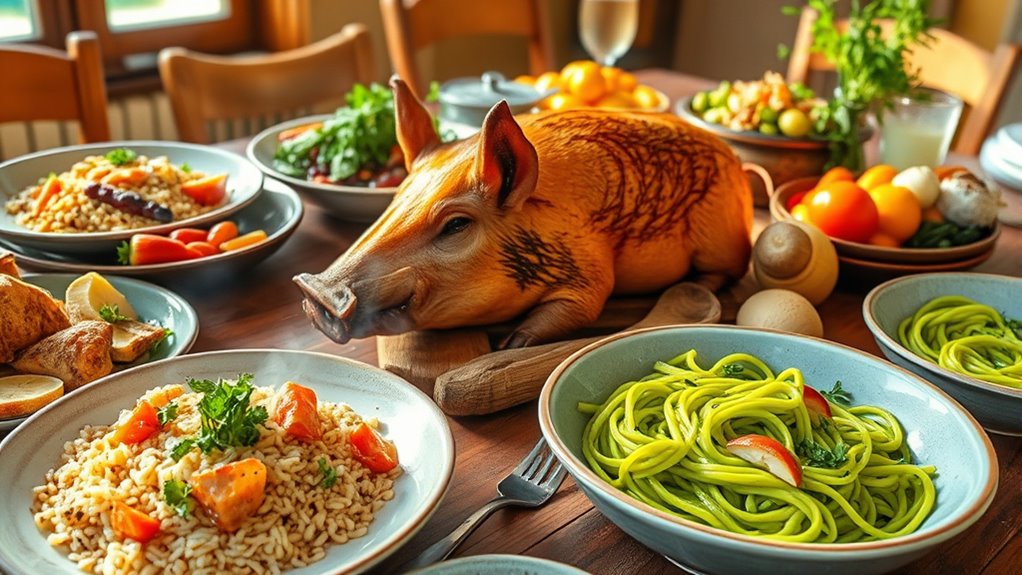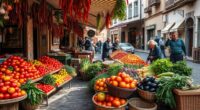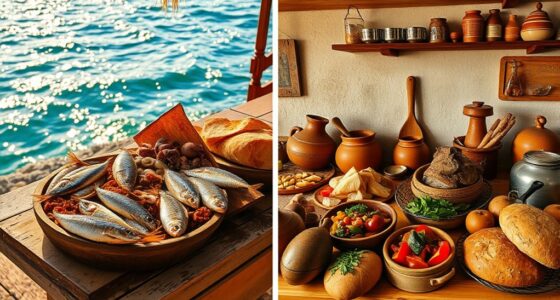If you want to experience authentic Sardinian cuisine, start with regional pasta like fregula and malloreddus, known for their hearty flavors and saffron notes. Don’t miss traditional dishes like porcheddu, a delicious roasted suckling pig, or fresh seafood such as seafood fregola and lobster alla catalana. Sample rustic bread casseroles, creamy pecorino cheese, and sweet Seadas drizzled with honey. With such rich flavors rooted in culture, exploring these dishes will be a tasty journey into Sardinia’s heart.
Key Takeaways
- Sardinian pasta varieties like fregula, malloreddus, and culurgiones showcase artisanal techniques and regional flavors.
- Hearty meat dishes such as porcheddu, panada, and rustic skewers reflect traditional pastoral and festive customs.
- Seafood specialties including seafood fregola, aragosta alla catalana, and bottarga highlight the island’s Mediterranean influence.
- Unique cheeses like Pecorino Sardo and sweet treats like seadas exemplify Sardinia’s dairy craftsmanship.
- Rustic broths and community dishes like favata emphasize resourcefulness and cultural heritage.
Sardinian Pasta Delights: Fregula, Malloreddus, and Culurgiones
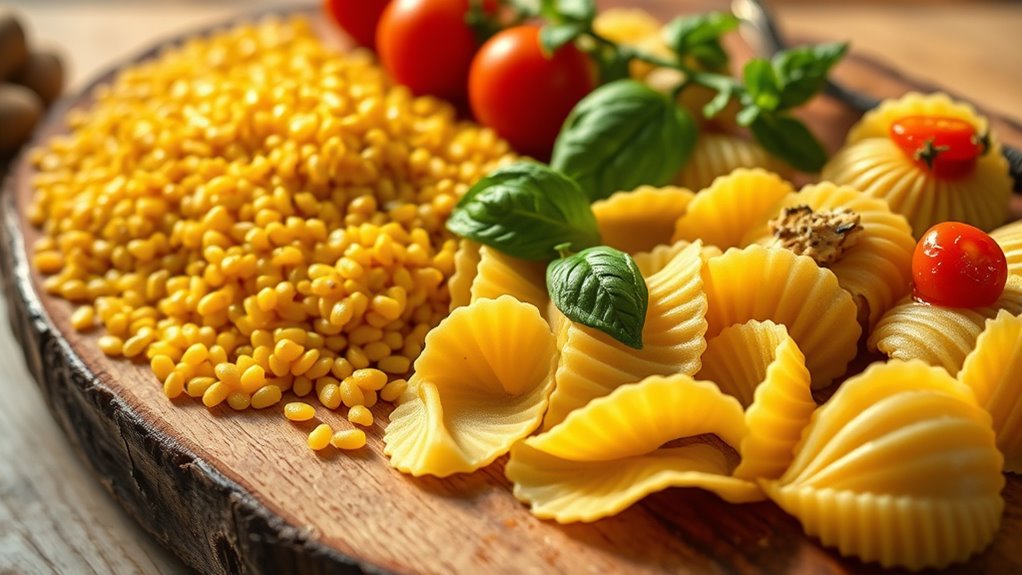
Have you ever tasted Sardinian pasta delights like fregula, malloreddus, and culurgiones? Each showcases unique craftsmanship rooted in local ingredients. Malloreddus, or Sardinian gnocchetti, are small, ridged ovals made from durum wheat semolina and water, sometimes infused with saffron. They’re firm, toothy, perfect for hearty sauces like ragù or tomato-based dishes. Fregula resembles toasted semolina beads, offering a nutty flavor and rustic look. These tiny balls excel in seafood soups, absorbing flavors while staying firm. Culurgiones are stuffed pasta, filled with potatoes, pecorino, and herbs, then sealed with a decorative pattern symbolizing Sardinian heritage. Usually served with light sauces or olive oil, culurgiones embody Sardinia’s artisanal culinary tradition. All three pastas highlight simple ingredients prepared with skill and cultural pride. Additionally, the traditional pasta-making techniques used in Sardinia contribute to the distinctive textures and flavors of each dish.
Savory Soups and Bread Classics: Gallurese Soup and Pane Frattau

Ever wondered how Sardinian cuisine transforms simple ingredients into hearty, comforting dishes? Gallurese Soup and Pane Frattau showcase this skill beautifully. Gallurese Soup layers soaked Carasau bread with a flavorful meat broth, cheeses like Pecorino Sardo, and herbs, then bakes everything into a dense, satisfying casserole. It’s a resourceful dish that highlights local cheeses and bread, perfect for colder days or family gatherings. Pane Frattau, on the other hand, features thin Carasau bread soaked in tomato sauce and broth, topped with a poached egg and grated cheese. Both use Sardinia’s signature bread and cheese, creating textures and flavors that are simple yet deeply satisfying. These dishes are deeply rooted in Sardinian culinary traditions, emphasizing the importance of regional ingredients and traditional preparation methods.
Signature Meat and Seafood Specialties: Porcheddu, Panada, and Spaghetti With Sea Urchin
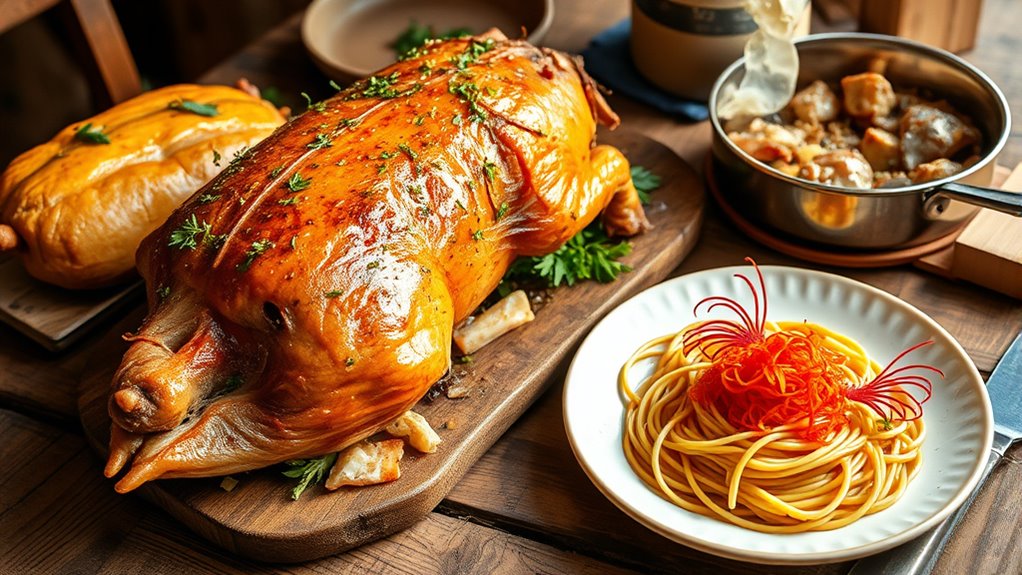
Sardinian cuisine showcases its rich culinary heritage through signature meat and seafood dishes that highlight local ingredients and traditional methods. Porcheddu, a whole suckling pig roasted over wood fire, embodies Sardinia’s festive spirit. It’s seasoned with herbs like rosemary, myrtle, and garlic, then slow-roasted for hours until the skin turns crispy and golden. Porcheddu is often served during large family gatherings and special occasions, reflecting its cultural significance. The technique of wood fire roasting imparts a unique flavor that is highly prized in Sardinian cooking. Panada, a savory pie filled with lamb, pork, or fish, features a flaky wheat crust and flavorful seasonings such as saffron and parsley, offering a comforting, portable meal rooted in pastoral life. Spaghetti with sea urchin showcases Sardinia’s maritime bounty. The delicate roe, combined with garlic, olive oil, and sometimes chili, creates a luxurious sauce that coats pasta strands, reflecting the island’s deep connection to the sea.
Unique Dairy Creations: Seadas and Pecorino Sardo
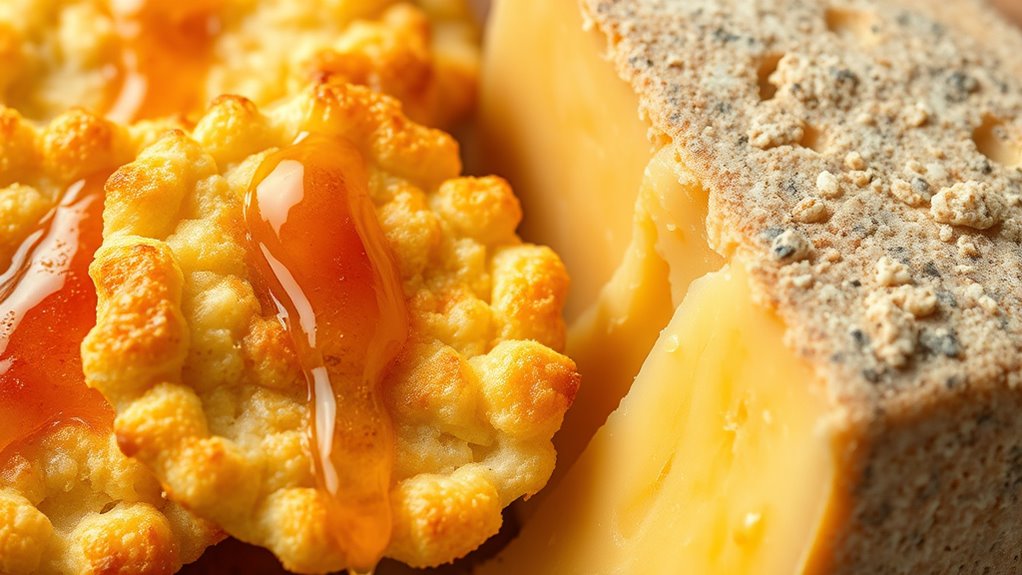
Among Sardinia’s rich culinary traditions, dairy products hold a special place, showcasing the island’s pastoral roots and artisanal craftsmanship. Pecorino Sardo, one of the oldest cheeses, has origins dating back to the Bronze Age. Made exclusively from local Sardinian sheep’s milk, it’s crafted using traditional methods that blend ancient practices with modern techniques. You’ll find two main varieties: fresh dolce and aged maturo, each with distinct flavors and textures. The cheese’s rind varies from deep yellow to dark brown, and its flavor intensifies with aging. Pecorino Sardo was awarded DOP (Protected Designation of Origin) status in 1996, ensuring its authenticity and quality. – Crafted in mountain huts called “pinnette” with smoky influences – Used for grating, slicing, and pairing with regional wines – Supports Sardinia’s rural economy and cultural heritage
Traditional Sardinian Sweets: Seadas and Pan’e Saba

Have you ever tasted the unique traditional sweets of Sardinia, like seadas and pan’e saba? Seadas are made from durum wheat semolina, lard, water, and salt, forming a crispy dough called *pasta violada*. The filling features soft, slightly acidic pecorino cheese with grated lemon rind, offering a bright, invigorating flavor. After assembling, you deep-fry them until golden, creating a crispy exterior that contrasts with the melted cheese inside. Toppings include local honey—like strawberry tree or chestnut honey—or powdered sugar. Originally a hearty, rustic dish for farmers, seadas have become an iconic Sardinian dessert, showcasing a balance of salty, sweet, and citrus flavors. Seadas are best served piping hot, so the melted, stringy cheese inside remains deliciously gooey when enjoyed immediately. Incorporating local ingredients is essential to achieving authentic flavors in Sardinian cuisine. Pan’e saba, on the other hand, is a dense, moist cake with flour, olive oil, and saba syrup, often enriched with nuts, enjoyed during harvest seasons.
Regional Flavors and Influences: Gallurese, Sassarese, and Alghero Dishes
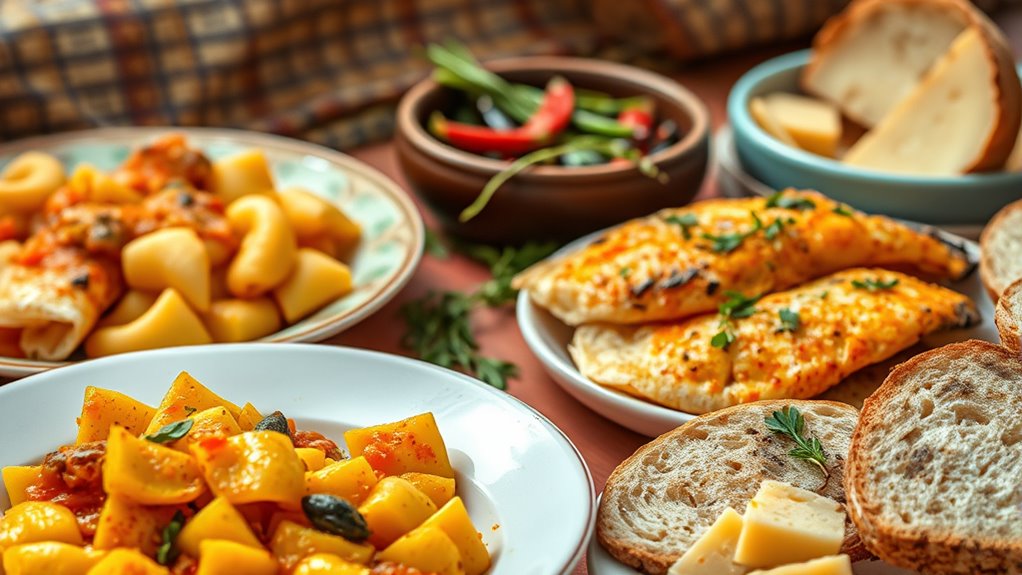
Explore how Gallurese dishes highlight rustic bread and cheese, reflecting the region’s pastoral roots. In Sassarese cuisine, hearty bean and pork recipes reveal local farming traditions and festive customs. Meanwhile, Alghero’s seafood and saffron-infused specialties showcase Mediterranean influences shaped by Catalan and Spanish history. Pane Guttiau, prepared with oil, rosemary, and myrtle leaves, exemplifies the regional use of local herbs and oils in Sardinian flavoring.
Gallurese Bread and Cheese
Gallurese bread and cheese exemplify the region’s resourcefulness and rich culinary traditions by transforming simple, everyday ingredients into a hearty and flavorful dish. You’ll layer sliced stale bread with grated pecorino sardo, black pepper, and cheese like casizolu or scamorza, soaked in hot mutton or beef broth. The dish is baked until bubbling and golden, creating a comforting casserole enjoyed at both casual and festive meals. Recognized for its regional significance, highlights include:
- Using regional cheeses like pecorino sardo and casizolu or scamorza
- Incorporating bread types such as pane carasau or stale wheat bread
- Variations with vegetables like Savoy cabbage for added texture
Additionally, traditional Sardinian cooking methods often involve slow baking to develop deep flavors and preserve the ingredients’ authenticity. This dish showcases Sardinia’s resourcefulness, blending rustic ingredients into a satisfying, layered masterpiece.
Sassarese Bean and Pork Dishes
Sassarese bean and pork dishes exemplify the region’s hearty and resourceful culinary traditions, emphasizing the full use of locally available ingredients. Favata, a classic stew, combines broad beans and various pork cuts like ribs, ears, and foot, slow-cooked with garlic, dried tomato, fennel, and chili. It’s traditionally served on carasau bread with olive oil, perfect for winter gatherings. Sanguinaccio di maiale, a rich blood sausage, uses fresh pork blood mixed with raisins, spices, and cured in intestines. Offal dishes like Zimino and Sa Cordula showcase grilled beef entrails and roasted intestines, celebrating nose-to-tail eating. These dishes reflect a robust, rustic flavor profile rooted in resourcefulness and tradition.
| Dish | Main Ingredients |
|---|---|
| Favata | Broad beans, pork cuts, vegetables |
| Sanguinaccio di Maiale | Pork blood, raisins, spices |
| Zimino | Beef entrails, simple seasoning |
| Sa Cordula | Roasted intestines, stomach lining |
| Pork and Bean Stew | Pork, broad beans, vegetables |
Alghero Seafood and Saffron
Have you ever tasted the vibrant flavors that define Alghero’s coastal cuisine? If not, you’re missing out on a seafood paradise infused with saffron’s aroma. In Alghero, seafood specialties shine, especially dishes like seafood fregola with saffron, blending local shellfish with aromatic saffron. You’ll also find:
- Aragosta alla catalana: Spiny lobster dressed simply with tomatoes, onions, lemon, and spicy herbs, reflecting Catalan influence.
- Bottarga: Sun-dried mullet roe served on bread or added to pasta for a delicate flavor.
- Cassola: A hearty seafood soup with mussels, clams, and octopus in Vermentino wine broth.
Saffron cultivation is prevalent near San Gavino Monreale, contributing to the unique regional dishes. Saffron adds warmth and depth without overpowering the fresh seafood. Pair these dishes with Sardinian wines like Vermentino for a truly authentic experience.
Shepherd-Inspired and Rustic Favorites: Ispinadas and Saffron Sheep’s Broth
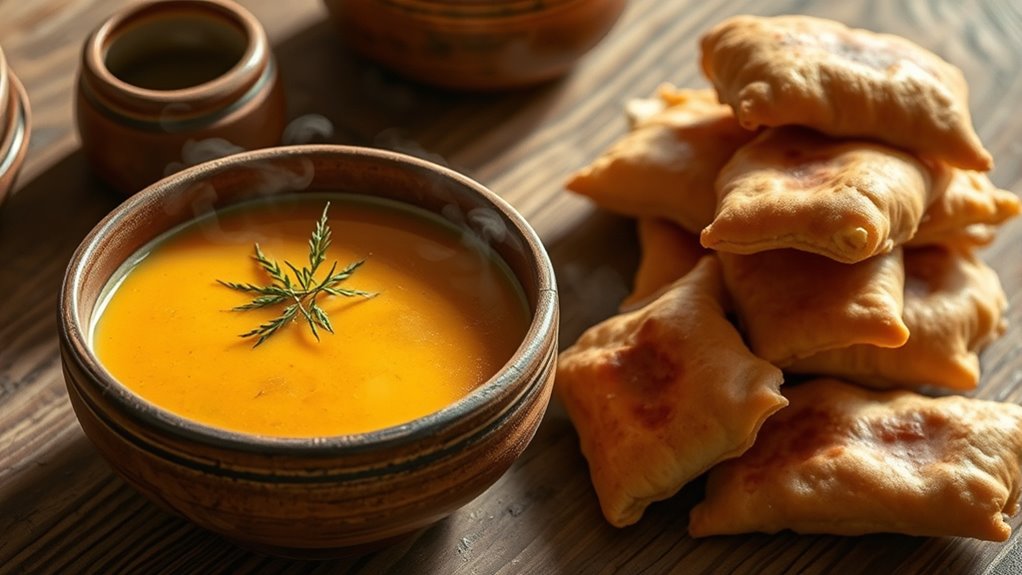
As you explore Sardinian cuisine, you’ll notice how shepherds created portable snacks like ispindas to sustain themselves in the field. The hearty sheep’s broth, infused with saffron and local herbs, showcases the island’s pastoral roots, while rustic meat skewers highlight simple, flavorful grilling techniques. Together, these dishes reflect Sardinia’s reliance on local ingredients and traditional methods that have stood the test of time. Sensory toys and interactive elements are also often incorporated into culinary experiences, enhancing the enjoyment and engagement of traditional dishes.
Shepherds’ Portable Snacks
Ever wonder how Sardinian shepherds kept energized during long days in the fields? They relied on simple, portable snacks that fueled their work and reflected local flavors. Ispinadas, small meat skewers made from lamb or sheep, were perfect for quick grilling over minimal fires—lean and fatty cuts threaded onto tiny skewers, turned frequently for even roasting. These portable bites offered rich protein and energy on the go. Alongside, rustic pies like panadas provided hearty sustenance, filled with fish, pork, or vegetables, sealed with crimped edges and baked to perfection. Sometimes, they carried a variant called sa panada, with chicken and potatoes, for extra comfort. These snacks highlight Sardinia’s resourceful use of local ingredients and their focus on convenience and nutrition during outdoor work.
- Small lamb skewers for quick, easy cooking over open flames
- Hearty, portable pies with durable dough and flavorful fillings
- Rustic, nourishing snacks that sustain shepherds long hours outdoors
Flavorful Sheep Broth
Sardinian shepherds not only relied on portable snacks like ispinadas but also crafted hearty, warming broths that sustained them through long, outdoor days. These rustic sheep broths, especially the saffron-infused variety, offer a deep, aromatic flavor. Made with lamb, vegetables, and saffron threads, they develop richness during slow simmering, creating a comforting bowl. The saffron adds a floral, golden hue and subtle earthiness, elevating the simple ingredients. Often served with fresh pasta or fregola, these broths balance bold meat flavors with delicate aromatics. They embody Sardinian pastoral traditions, providing nourishment and warmth. Here’s a closer look:
| Ingredient | Role | Flavor Notes |
|---|---|---|
| Lamb meat | Base protein | Rich, savory |
| Saffron threads | Aromatic infusion | Floral, earthy, sweet |
| Vegetables | Flavor foundation and texture | Umami, sweetness |
Rustic Meat Skewers
Rustic meat skewers, known locally as Ispinadas, embody the hearty, straightforward spirit of Sardinian shepherd cuisine. You’ll notice the meat—usually lamb or sheep—is cut into small cubes, seasoned simply with salt, pepper, and local herbs like rosemary or myrtle. These skewers are grilled over open wood or charcoal fires, giving them a smoky, rustic flavor that’s hard to beat. Shepherds prepared Ispinadas as portable meals during seasonal transhumance, making them a staple at family gatherings and festivals. They’re typically served with flatbread or rustic bread and fresh vegetables to keep the meal authentic and simple. The traditional preparation of Ispinadas involves marinating the meat with herbs and olive oil, which enhances the flavor and tenderness. Using local herbs like rosemary and myrtle for flavor helps to highlight the regional culinary traditions, ensuring an authentic experience. Pair with pane carasau or roasted potatoes to complement the smoky flavors. Enjoy with Sardinian red wine, such as Cannonau, to complete this rustic feast.
Frequently Asked Questions
What Are the Key Ingredients in Traditional Sardinian Pasta Dishes?
You’re curious about the key ingredients in traditional Sardinian pasta dishes. You’ll find semolina flour forms the base of the pasta, giving it a firm texture. Potatoes, pecorino cheese, and tomatoes are common in various fillings and sauces. Saffron adds color and earthiness, while fresh herbs like mint and basil brighten flavors. Olive oil and garlic are essential for depth, making Sardinian pasta rich, flavorful, and unique.
How Do Sardinian Soups Vary Across Different Regions?
You’ll notice that Sardinian soups vary widely, much like the landscapes themselves. Inland regions favor hearty, herb-rich bean and greens soups, using mountain herbs and preserved ingredients for survival. Coastal areas, however, prefer lighter, fresher broths with local vegetables and seafood influences. These differences reflect the island’s diverse environment and culture—rural mountain communities rely on robust, plant-based recipes, while coastal villages embrace lighter, ocean-inspired flavors.
What Makes Porcheddu a Must-Try Sardinian Meat Specialty?
Porcheddu stands out as a must-try Sardinian meat specialty because it embodies the island’s rich cultural traditions and pastoral heritage. You get to experience a dish that’s slow-roasted over aromatic woods, resulting in crispy skin and tender, flavorful meat. Its preparation is a social event, celebrating community and history. The smoky, herbal aroma and rustic presentation make it a truly authentic taste of Sardinia’s culinary soul.
Which Cheeses Are Essential in Sardinian Cuisine?
Cheeses are the soul of Sardinian cuisine, like a heartbeat that keeps traditions alive. You’ll want to taste Pecorino Sardo DOP Dolce for its gentle sweetness, and Fiore Sardo DOP for its smoky, bold flavor. Don’t miss the mature varieties like Gran Sepi Riserva, or the infamous Casu marzu for an adventurous bite. These cheeses, made mainly from sheep’s milk, truly capture Sardinia’s authentic, robust taste.
How Do Regional Influences Shape Sardinian Desserts?
Regional influences deeply shape Sardinian desserts, blending Mediterranean, Spanish, and Italian traditions. You’ll notice local ingredients like sheep’s milk, honey, citrus, and nuts define their flavors and textures. Traditional techniques such as honey-infused doughs and deep-frying create unique, rich desserts. The island’s history and geography also inspire seasonal and regional variations, making Sardinian sweets a reflection of its diverse cultural tapestry and natural bounty.
Conclusion
As you explore Sardinia’s rich culinary tapestry, you might find yourself savoring a plate of pasta or a spoonful of hearty soup, just like a local. Sometimes, the best discoveries happen when you least expect it—perhaps a hidden trattoria serving authentic Seadas or a seaside spot with fresh Spaghetti with Sea Urchin. Embrace these moments, and let Sardinian flavors create unforgettable memories on your journey through this enchanting island.
